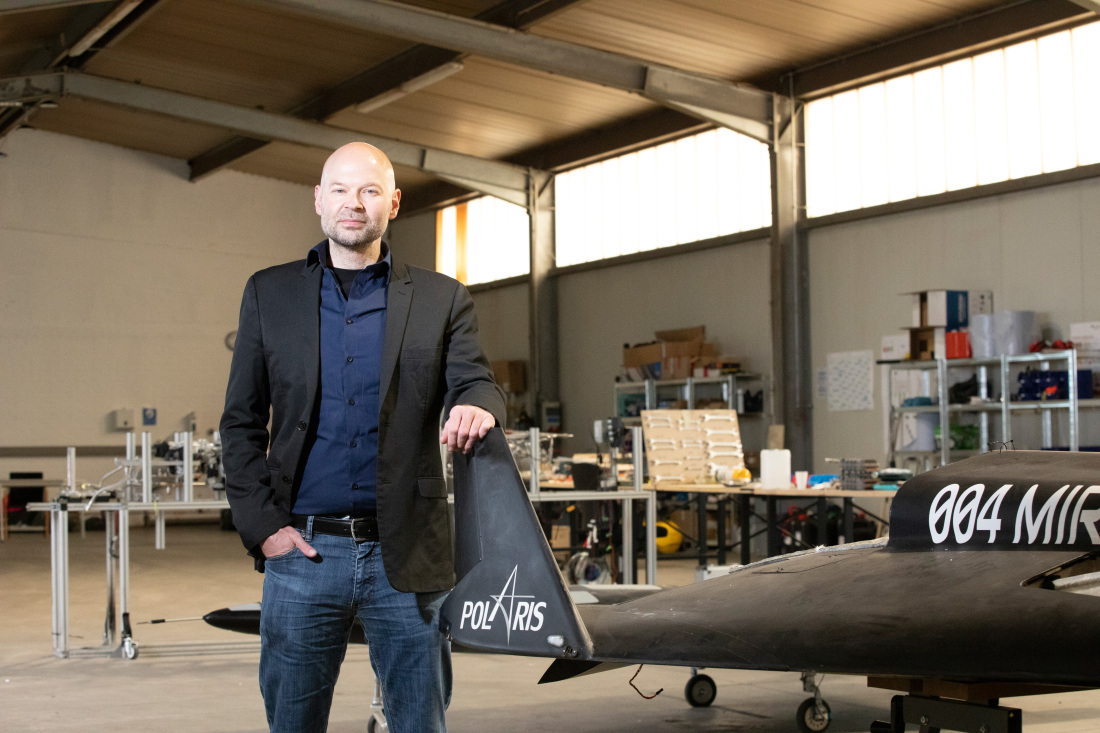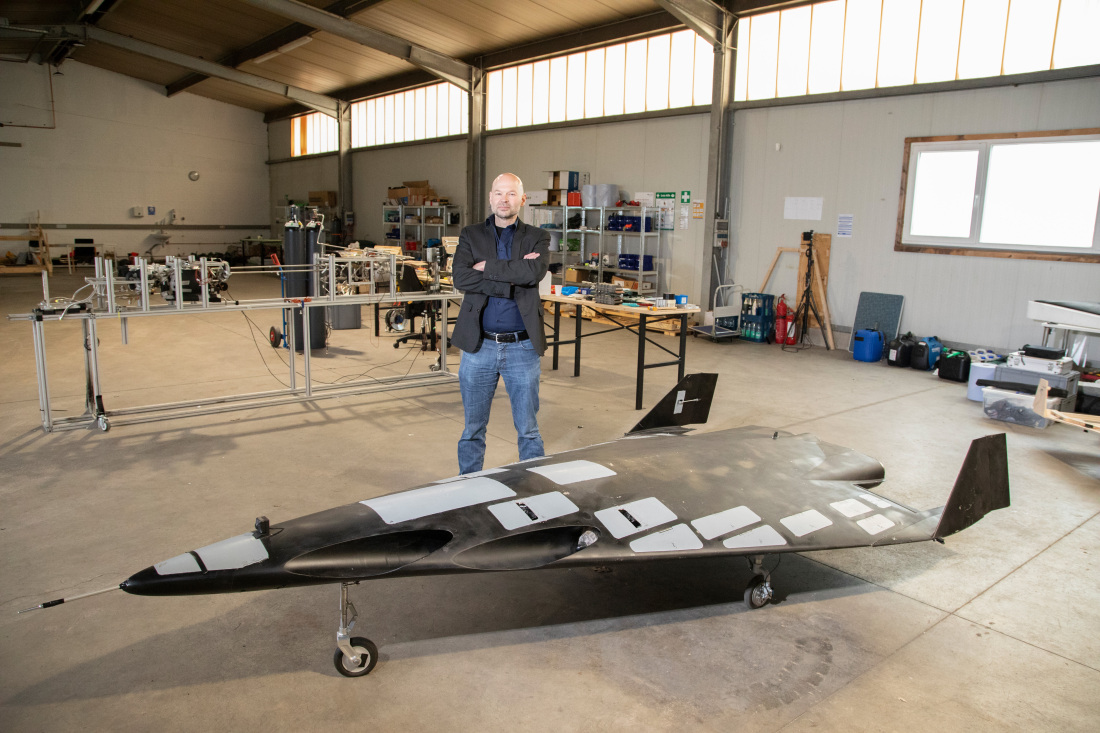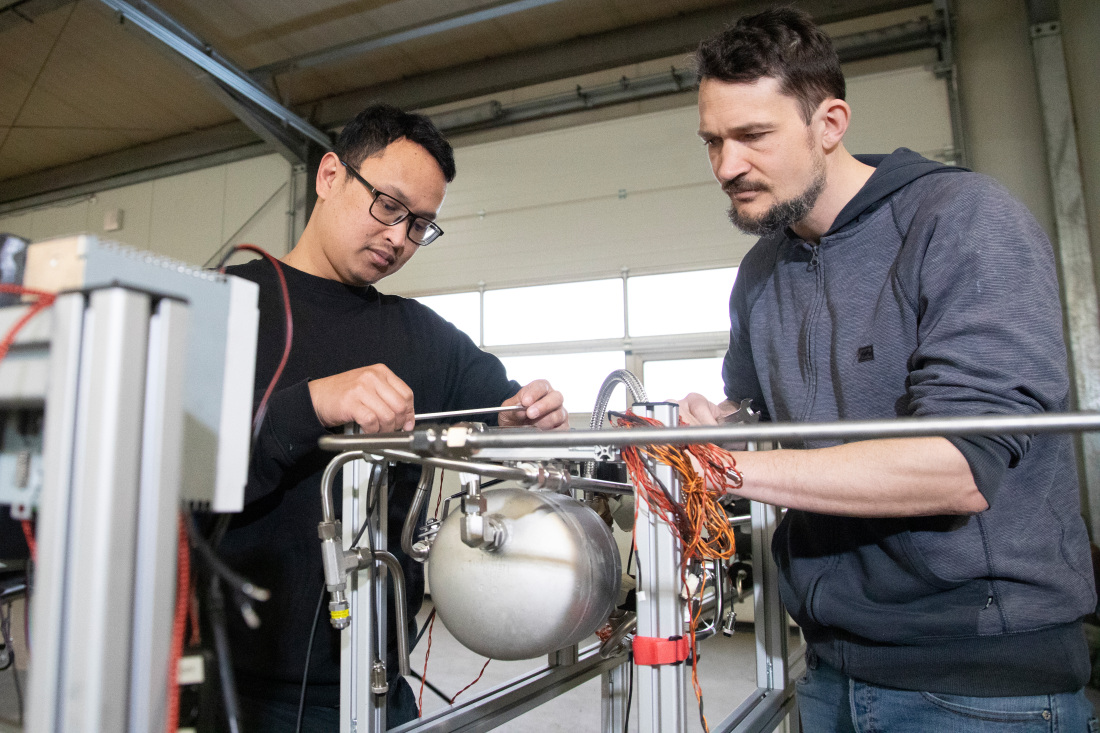On the Way to Space
AerospaceA Bremen start-up is working on reusable spacecraft

A space rocket that can take off and land like an airplane: that's the idea that's being pursued by the Polaris start-up in Bremen. Compact test models are already flying and "Aurora" is scheduled to lift off in 2028. This invention could revolutionise the market because the space vehicles could be reused up to 200 times and could set off into space from any airport in the world.
"The Sky is not the Limit. Beyond the Universe is." is the motto above the entrance door to Polaris, the Bremen-based start-up company. Anyone who meets Alexander Kopp, the Managing Director, soon finds out why this quotation means so much to him. The 42-year old entrepreneur has really big plans. Together with his colleagues, he is developing a space vehicle that will take payloads into space. The revolutionary aspect of Kopp's invention is that these vehicles can take off and land on a runway: they don't need a launch pad. And they can be reused up to 200 times. In future, it would therefore be possible to fly into space from any airport in the world.
This would be a real breakthrough for the company, but is also an enormous challenge. Alexander Kopp works extremely long hours and he needs people to take his company forward. He plans to increase the workforce from 20 to 35 by the end of the year. "And that still won't be enough", said Kopp.
"You have to test, test and test again."
To speed up progress on the space vehicle, Polaris has developed a range of smaller flight demonstrators that are sent off on regular test flights. For example, there is the "Mira": a projectile, almost four and a half meters long, designed to show that the technology works. However, "Mira“ has proved to be a bit contrary. On a test flight in February 2024, she came off the runway and landed in the grass. Alexander Kopp doesn't see this as anything to worry about: "We really don't think that was critical. If you want to make progress, you must push things forward aggressively. Things like that are simply part of the process." At the end, when the space vehicle is finished, it will be 28 metres long. And until then, we have to move forward cautiously, step-by-step", said Kopp. This means that every demonstrator will be a little bit longer than its predecessor. As Klopp explained, "You have to test, test and test again. This is the only way to develop a better understanding of the system."

A revolution for global space travel
In one respect, the idea behind "Mira", that a flying machine should be able to take off and land like an airplane, isn't new. However, Polaris's technology could mean a revolution for global space travel. The start-up company, located in the industrial estate near the Bremer Kreuz motorway junction, uses two different types of engine for its space vehicle. During take-off, it is the turbine engines that are used. When the vehicle is flying, the "Aerospike Engines" (rocket engines) are ignited to provide the propulsion needed for supersonic flight. These engines are the company's own development, made in Bremen. At a height of 100 kilometres, when the upper stage is travelling at seven to ten times the speed of sound, it will encounter satellites. After successfully completing its mission, the "spaceplane" will land back on the runway, horizontally.
Back in the 1990s, Europeans had taken a similar approach with the "Hopper" project, but only a few attempted flights ever came of this invention. As Polaris's Managing Director, Alexander Kopp, said "The market wasn't ready for this system then". And cost pressures back then were not as great as they are today. Since then, the market has changed fundamentally: Space-X, owned by the American billionaire Elon Musk, has proved that space flight can be less expensive. By doing so, Space-X has put its competitors under pressure. "The whole subject of space vehicles has gained momentum again", said Kopp.

Reusable for up to 200 times
For the company's founder from Bremen, the advantages of his innovation are clear to see: the system can be used up to 200 times and made ready for reuse within 24 hours, saving an enormous amount of costs in comparison with any other reusable rocket, said Kopp. From his viewpoint, yet another competitive advantage that the Polaris system has over "traditional" rockets is that "spaceplanes" can take off from standard airports. "This means we can operate world-wide", explained Kopp, who has been fascinated with space since his earliest years.
And this fascination has remained with him. By starting his company, Alexander Kopp has put all his eggs in one basket. After spending ten years working on reusable space vehicles, at the German Aerospace Center (DLR), he struck out on his own by founding Polaris and investing everything he had in the company. "There came a point at which I had done enough research and I was convinced that it was the right time to launch a start-up", remembered the systems engineer. His first thought was to site the company far away from Bremen and transform his family's old farm steading into a space vehicle development centre. He now admits that "that really was the most idiotic idea of all time". The rebuilding costs would have completely blown his budget and, on closer inspection, the location proved to be unsuitable. "I lost a lot of time doing that". His start-up certainly had a rocky beginning.
Off to the "City of Space"
However, he remained focussed on his mission. Finally he moved, together with Polaris, to Bremen's "City of Space". This was primarily due to the search for suitable employees, said Kopp. "The most important question about any location is: where do I get the staff? And Bremen is, after all, one of the largest aviation and aerospace cities." The Federal State of Bremen has the largest number of people involved in aviation and aerospace in Germany, per head of population. The Federal State of Bremen is home to more than 140 companies and twenty institutes that are involved in this sector.
Klopp also remarked that Bremen's proximity to the coast is a great advantage. His colleagues regularly travel to Peenemünde on the island of Usedom because the airspace over the sea can be "cordoned off" for test flights.
And Alexander Kopp has already planned the next test flight: "Mira II", which is larger than its predecessor, will take to the air for the first time in July 2024. Things are steadily getting more serious. Everything will be ready in four years time. That is when the "Aurora", a 28-meter long lightweight "spaceplane" with a 15 meter wingspan, carrying a one-tonne orbital payload, is scheduled to take off. But Kopp is already thinking about what comes after that: the second generation of spaceplanes will be much heavier. They will be able to go into orbit around the earth and carry a ten-tonne payload. The first flight of the "Heavy Spaceplane" is planned for 2030 and could well usher in a new era of space travel.
Success Stories
Take-off for Bremen: what makes the city a hub for aerospace expertise
The sky is not the limit. Science, production, development and business all agree on this. Aircraft wings, Ariane rockets, Galileo satellites - Bremen is one of the top locations in the international aerospace industry. Five reasons for Bremen's success story.
Learn moreLife on Mars
Humans on Mars? Still a distant dream for now. Yet, a Bremen science initiative is developing the foundations for sustainable human life on the Red Planet. This affects Earth, too. After all, these technologies could also be pioneering for the Blue Planet.
Learn moreThe Polymath from Horn-Lehe
No can do? No such thing! GERADTS GMBH makes the things other companies can’t even imagine. This is why this engineering firm is so firmly rooted in major European aviation and aerospace projects, and also in a myriad of other sectors.
Learn more
